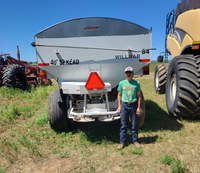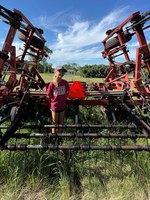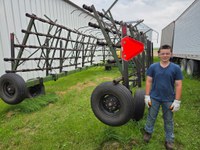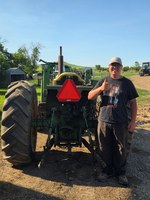2025 NDSU Extension Farm Safety Camp participants recognized during National Farm Safety and Health Week
(Click an image below to view a high-resolution image that can be downloaded)
-

Lane Petrick of Grant County, North Dakota, placed first for properly installing a slow-moving vehicle sign on a Wilmar pull-type 40’ fertilizer spreader. (NDSU photo) -

Reese Eggert of Becker County, Minnesota, placed second for properly installing a slow-moving vehicle sign on a Case-International vibra shank cultivator. (NDSU photo) -

Ryan Steger of Richland County, North Dakota, placed third for properly installing a slow-moving vehicle sign on an applicator-equipped harrow. (NDSU photo) -

Carter Roth of Grant County, North Dakota, placed fourth for installing a slow-moving vehicle sign on an open-cabbed John Deere tractor. (NDSU photo)
Participants of the 2025 North Dakota State University Extension Farm Safety Camps are being recognized for their efforts to implement farm and ranch safety practices.
“In honor of National Farm Safety and Health Week, the North Dakota State University Extension farm and ranch safety team is celebrating the work of 15 youth who participated in the Slow-Moving Vehicle Sign Challenge,” says Angie Johnson, farm and ranch safety specialist for NDSU Extension.
National Farm Safety and Health Week is celebrated each year in September, with this year’s theme, “Safety First, Avoid the Worst”.
Youth who participated in the 2025 NDSU Extension farm safety camps received a new slow-moving vehicle sign from Bobcat, Extension’s farm safety camp partner. Camp leaders challenged the young people to identify an unmarked piece of farm or ranch equipment that travels on public roadways and install the new sign.
Many slow-moving vehicle signs on farm equipment are faded, broken or missing. As part of the challenge, participants took a photo of equipment that needed a new slow-moving vehicle sign. Then, they installed the slow-moving vehicle sign and took a photo of its placement.
Bobcat’s product safety and compliance teams, comprised of engineers and safety professionals from across the U.S., reviewed the before-and-after photos. These safety professionals then selected the top four winners based on the slow-moving vehicle sign standards set by the American Society of Agricultural Biological Engineers.
The top four winners for the 2025 Slow-Moving Vehicle Challenge are:
- First place – Lane Petrick of Grant County, North Dakota, for installing a slow-moving vehicle sign on a Wilmar pull-type 40’ fertilizer spreader.
- Second place – Reese Eggert of Becker County, Minnesota, for installing a slow-moving vehicle sign on a Case-International vibra shank cultivator.
- Third place – Ryan Steger of Richland County, North Dakota, for installing a slow-moving vehicle sign on an applicator-equipped harrow.
- Fourth place – Carter Roth of Grant County, North Dakota, for installing a slow-moving vehicle sign on an open-cabbed John Deere tractor.
“We know that habits start early in life,” says Amelia Doll, product safety communication specialist for Bobcat. “Partnering with NDSU Extension to help build safe habits when operating equipment has been a great opportunity for Bobcat. We know youth initiate change on and off their farms. These positive and safe habit changes transfer to others on the farm. The partnership between Bobcat and NDSU Extension has been a great opportunity to instill safe operating practices for these operators to use and teach others around them.”
Slow-moving vehicle signs are triangle-shaped emblems with a fluorescent orange center and a reflective red border. When equipment operators are moving equipment on public roadways, a slow-moving vehicle sign is required by law to be placed on the equipment. These signs help alert rear-approaching traffic of a slow-moving vehicle, so motorists can slow down to avoid a rear-end collision with the equipment.
“If a car is traveling 60 mph and is approaching a tractor ahead of them that is driving 20 mph, it only takes the car 6.5 seconds to travel 400 feet to reach the tractor – this is a common way that motorists can get caught in a rear-end collision with farm equipment on the roadway, especially if motorists are distracted while driving,” Johnson says.
Slow-moving vehicle signs are only allowed on equipment that travels less than 25 mph and are not to be used on stationary items, such as mailboxes, fence posts or gates.
“The challenge was a great opportunity for youth to put their new knowledge into practice by drawing attention to slow-moving vehicles across the state,” Doll says. “Often, roadway crashes involving farm equipment happen when drivers misjudge the distance between themselves and farm equipment.”
“This contest helped to connect our future drivers with farm equipment roadway safety,” Johnson says. “Whether you are driving farm equipment or a car, it is always your responsibility to be a defensive driver and share the road. We cannot thank Bobcat enough for partnering with us to provide each farm safety camp participant with a slow-moving vehicle sign to install on their own farm equipment. Farm safety is a team sport – requiring everyone to play and be committed to practicing safety first.”
During this year’s harvest season, the NDSU Extension farm and ranch safety team challenges all farmers and ranchers to review and replace any worn or missing slow-moving vehicle signs from slow-moving equipment before driving on public roads.
For more information on slow-moving vehicle laws and sign placement, visit: ndsu.ag/roadsafety and click on the “ND Agriculture Transportation Handbook” for more details.
The Association of Equipment Manufacturers offers a free guide, “Lighting and Marking of Agricultural Equipment on Highways.” Contact your county NDSU Extension agent to access the guide.
NDSU Agriculture Communication – Oct. 8, 2025
Source: Angie Johnson, 701-231-1873, angela.b.johnson@ndsu.edu
Editor: Kelli Anderson, 701-231-6136, kelli.c.anderson@ndsu.edu

